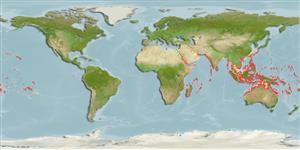>
Eupercaria/misc (Various families in series Eupercaria) >
Labridae (Wrasses) > Cheilininae
Etymology: Epibulus: Greek, epi = over, in front + Greek, boleo = to throw (Ref. 45335).
More on author: Pallas.
Environment: milieu / climate zone / depth range / distribution range
Ekologi
marina revassocierade; djupintervall 0 - 50 m (Ref. 128797). Tropical; 30°N - 30°S
Indo-Pacific: Red Sea to South Africa (Ref. 35918) and the Hawaiian and Tuamoto islands, north to southern Japan, south to New Caledonia.
Size / Vikt / Age
Maturity: Lm ? range ? - ? cm
Max length : 54.0 cm SL hane/ej könsbestämd; (Ref. 9823)
Taggstrålar i ryggfenan (totalt) : 9 - 10; Mjukstrålar i ryggfenan (totalt) : 9 - 11; Taggstrålar i analfenan: 3; Mjukstrålar i analfenan: 8 - 9. The mouth of this species is protrusible and unfolds into a tube easily half the body length. The jaws swing forward into a long tube that strong suction to catch prey. When not in use, the entire apparatus is conveniently folded under the head. Small juveniles are brown with thin white bars and closely resemble a species of Wetmorella. Color varies with age and sex, but adult color varies additional, including with an all-yellow xanthic form. Sub adults and females are brown or, not uncommonly, uniformly yellow. Terminal males are dark with a white head and a dark streak extending horizontally through the eye. Male becomes ornamented with orange and yellow over the back. Juveniles dark with fine vertical white lines. Intermediates with yellow blotches, pale tail and sometimes with black pectoral fins (Ref. 48636).
Inhabit coral-rich areas of lagoon and seaward reefs (Ref. 1602, 58302). Benthopelagic (Ref. 58302). Generally solitary (Ref. 5213). Feed on small coral-dwelling crustaceans and fishes (Ref. 9710). Capable of drift migration along with floating leaves (Ref. 27153). Adults usually along deep slopes or drop-offs. Sometimes they visit cleaning stations holding their mouth open and out for inspection (Ref. 48636).
Life cycle and mating behavior
Könsmognad | Reproduktion | Lek | Ägg | Fecundity | Larver
Males have been observed patrolling their mating territory (see Ref. 27152). Protogyny was proposed but not confirmed (Ref. 103751).
Randall, J.E., G.R. Allen and R.C. Steene, 1990. Fishes of the Great Barrier Reef and Coral Sea. University of Hawaii Press, Honolulu, Hawaii. 506 p. (Ref. 2334)
IUCN Red List Status (Ref. 130435: Version 2024-2)
Threat to humans
Reports of ciguatera poisoning (Ref. 4690)
Human uses
Fiskeri: mindre kommeriell; Akvarium: Kommersiell
Verktyg
Special reports
Download XML
Internet-källor
Estimates based on models
Preferred temperature (Ref.
123201): 24.7 - 29, mean 27.9 °C (based on 790 cells).
Phylogenetic diversity index (Ref.
82804): PD
50 = 0.7500 [Uniqueness, from 0.5 = low to 2.0 = high].
Bayesian length-weight: a=0.02239 (0.01234 - 0.04062), b=2.95 (2.79 - 3.11), in cm total length, based on LWR estimates for this species & (Sub)family-body (Ref.
93245).
Trofisk nivå (Ref.
69278): 4.0 ±0.66 se; based on food items.
Resiliens (Ref.
120179): Låg, lägsta populationsfördubblingstid 4,5-14 år (Preliminary K or Fecundity.).
Fishing Vulnerability (Ref.
59153): Moderate to high vulnerability (46 of 100).
Nutrients (Ref.
124155): Calcium = 36.4 [12.3, 145.1] mg/100g; Iron = 0.515 [0.197, 1.250] mg/100g; Protein = 18.4 [15.4, 20.7] %; Omega3 = 0.133 [0.067, 0.276] g/100g; Selenium = 32.4 [11.6, 84.5] μg/100g; VitaminA = 65.8 [17.4, 310.7] μg/100g; Zinc = 1.95 [0.61, 3.51] mg/100g (wet weight); based on
nutrient studies.
